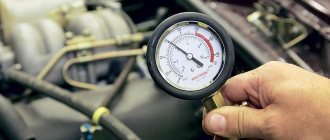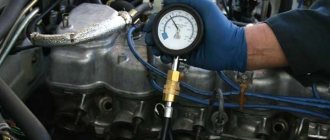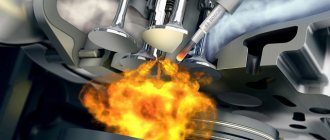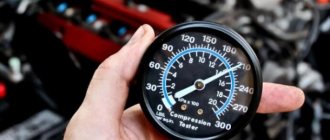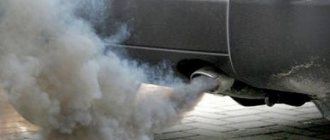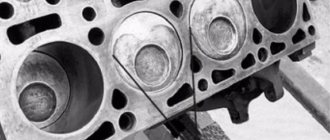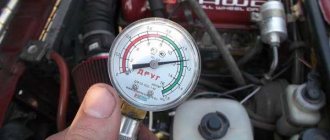Compression is the amount of maximum pressure in the cylinder created when the engine is idling with the starter (for example, when the spark plug is turned off). Engine compression should not be confused with the compression ratio, because these are different concepts.
Compression is a force exerted on a gaseous body, leading to a decrease in the volume it occupies, as well as an increase in pressure and temperature. In the broadest sense of the word, compression is the amount of pressure that is created in the cylinder at the end of the compression stroke.
When diagnosing malfunctions associated with interruptions in engine operation, the first step is to measure the compression. This will give you the right direction for further troubleshooting. You can improve the ignition and fuel supply as much as you like, but if the cylinder is not sealed enough, then it will not work normally. Timely compression measurements can detect cylinder depressurization in the early stages, thus saving money on repairs and time in troubleshooting.
Diesel engines are especially demanding on compression, since in them the fuel ignites without the use of a spark plug. In such an engine, a portion of fuel is injected through a nozzle into air heated from compression in the cylinder (to a temperature exceeding the ignition temperature of the fuel). As a result, if there is no decent compression, then there will be no conditions for ignition of diesel fuel. During the injection of the fuel mixture, it is atomized, and then combustion centers appear around individual droplets of the fuel mixture; as the fuel mixture is injected, it burns in the form of a torch. Since diesel engines are not subject to the phenomenon of detonation characteristic of engines with forced ignition, they can use higher compression ratios (up to 26), which, in combination with long combustion, ensuring constant operating pressure, has a beneficial effect on the efficiency of this type of engine , which can exceed 50%.
Criteria and norms of compression in cylinders
There is a point of view among owners of innovative vehicles that the pressure of a heated internal combustion engine can be from eight to ten atmospheres.
The machines use engines of different configurations, depending on the number of valves and camshafts, the shape of the intake manifold, and the built-in connecting rod-piston system. According to this, its specific level of pressure is determined - this is the ratio of the capacity of the cylinder to the capacity of the combustion chamber.
The higher the compression level, the higher the compression number. For engines running on gasoline, the compression indicator lies in the range of eight to twelve units, which is indicated in the registration certificate of a particular vehicle.
In theory, it is not difficult to calculate what the pressure in the cylinders should be for a particular engine. It is necessary to multiply the compression level by a factor of 1.3.
Insufficient compression: what to do
Operating a vehicle with low pressure in the cylinders leads to damage to the CPG and timing parts. Moreover, the longer you do not take the necessary measures, the more expensive it will ultimately cost to repair the power unit. The most characteristic signs of compression loss:
- the engine became noticeably harder to start;
- engine operation is unstable in all modes;
- glutton of oil;
- fuel consumption has increased;
- the cylinders work poorly (the engine “troits”);
- an increase in pressure in the cooling system: antifreeze will begin to be squeezed out from under its gaskets;
- With a diesel engine, you can hear popping noises when the engine is running.
If the process of wear of timing elements and the cylinder-piston group has not reached a critical level, then you can use special additives that will somewhat delay the overhaul. You can also use a folk remedy, but only when the reason for the decrease in compression is the formation of a dense crust of deposits on the cylinder bore and piston heads. The procedure is as follows:
- Prepare denatured alcohol and kerosene.
- Mix 25 ml of each component in a suitable container (this is the volume of solution - 50 ml - for one cylinder).
- Start the power plant and warm it up, then turn it off.
- Turn out the candles and insert 50 g of the mixture into each hole.
- Leave the vehicle for 12 hours (overnight is possible).
- Inject 4-5 g of motor oil into the cylinders using a disposable syringe, screw in the spark plugs, start the internal combustion engine and let it run for half an hour. During this time, the deposits formed will burn out.
Instead of a mixture of kerosene and denatured alcohol, you can use special products for cleaning carbon deposits, sold in car dealerships. In this case, the algorithm of actions is slightly different:
- Unscrew the spark plugs and pour the purchased solution (30-40 g per cylinder) into the empty holes.
- Cover the holes with a rag to prevent dirt from getting in.
- Leave the car for 10-12 hours.
- Remove the rags and, without screwing in the spark plugs, crank the engine with the starter for 20-30 seconds.
- Clean the spark plugs and screw them in.
- Start the car, warm up the engine and drive out onto the highway. Accelerate the car to 110-130 km/h. At this speed it is recommended to drive 25-30 km.
Attention: do not try to screw in the spark plugs and start the car after filling the fluid in less than 10 hours: the remaining product can lead to water hammer and breakage of the CPG parts. After this, take compression measurements again. If it remains at the same level, then you will have to seriously restore the performance of the engine. This means replacing the rings, the pistons themselves and boring the cylinders (liners) to the nearest repair size.
How to measure compression in an engine
The procedure is carried out with a special device - a compression gauge, which includes the following components:
- Pressure gauge with thread;
- A metal pipe or soft hose with a built-in shut-off valve and an air release button;
- A part for screwing into a cylinder, fed by adapters for other threads or a rubber cone.
The pressure gauge is built into the tube (flexible hose), with a thread on the opposite side. The check valve is necessary to determine the pressure gauge readings, since during testing the piston gains pressure within a couple of crankshaft rotations (about ten).
To control gasoline and diesel internal combustion engines, pressure gauges with different measuring scales can be used. If for engines operating on gasoline a device provided for twenty to twenty-five Bars is sufficient, then to study a diesel engine you will need a scale of at least fifty Bars.
Data analysis
If you do everything correctly, you will be able to take correct values. Different types of engines have their own standards, with which it is worth comparing the results obtained.
| Motor type | Minimum value, Bar | Optimal indicator, Bar |
| Old gasoline engines with a compression ratio of up to 8.5 | 11 | 13 |
| New engines, with a compression ratio of 8.5 | 12 | 14-15 |
| Diesel units | 22 | 30 |
How to measure compression in an engine?
For an initial general assessment of compression in the cylinders of a gasoline internal combustion engine, the following rules must be followed:
- Heated to the optimal temperature;
- Spark plugs are turned out from all cylinders;
- The fuel supply is turned off (on injection engines you need to turn off the crankshaft position converter, on carburetor engines you need to turn off the fuel intake from the fuel pump);
- The generator is fully charged or additionally connected to the starting unit;
- The starter is in working order;
- The clutch pedal is depressed;
- Throttle valve is open;
- The measuring modes for all cylinders are identical in terms of the speed of cranking by the starter (or the number of strokes).
What to do if the compression meter measurements do not please you
If at least one of the measurements has a strong deviation from the norm, this may indicate problems with the motor. In this case, the engine needs to be repaired. With reduced data, we can talk about the following malfunctions:
- Wear of pistons, liners and rings (if the indicators are reduced identically). When adding 5 ml of engine oil to the cylinders, the compression should increase - this will confirm the previous analysis of measurements.
- With different indications, there may be a problem with valve leaks.
- Piston destruction in various places (side or center).
All malfunctions due to wear of individual parts are repaired by disassembling and replacing a specific accessory with a new one. However, the best solution would be to replace all valves, since changing one may soon cause the next one to break. The same kit replaces all pistons.
Compression testing is the most effective method of testing the correct operation of the engine. It is the first priority point in the algorithm for checking the main installation of the machine. Based on the data obtained from the compression meter, it is easiest to make a decision - to carry out further inspections and look for the problem, or to proceed directly to the dismantling and detailed repair of the motor itself.
Compression testing devices
A compression gauge is a unit that contains a pressure gauge with a scale, a pressure relief valve and tips.
The most practical is considered to be an elastic hose with a thread, where a nipple is mounted to prevent air from escaping back out of the device.
The study of compression in internal combustion engine cylinders, which involve spark plug wells in the construction, is carried out by screwing a flexible hose into the threaded slot of the spark plug, which does not allow the passage of compressed air from the leaky contact of rigid tips without threads.
Compressometer
ATTENTION! A completely simple way to reduce fuel consumption has been found! Don't believe me? An auto mechanic with 15 years of experience also didn’t believe it until he tried it. And now he saves 35,000 rubles a year on gasoline! Read more"
Measuring compression indicators is best done with a compression meter operating on the principle of a pressure gauge. If the latter measures tire pressure and is designed for light loads, then the compression meter is a more powerful unit. Compare the pressure inside the engine and the tire, and then the difference between the two devices will become visible. However, the principle of their functioning is largely similar.
Today, there are three types of compression meters.
- For gasoline units.
- For diesels.
- A universal option used for diagnosing power units of any car.
In addition to the fact that compression meters come in different types, they also differ in models.
A compression meter is a diagnostic unit that is part of the mandatory tools for maintenance. Experienced motorists use it to analyze the technical condition of the engine without using expensive service stations. A good compression meter allows you to carry out diagnostics yourself, without the help of an assistant, which is also considered a big plus. As soon as I noticed problems with the engine, I took it and checked it.
A prerequisite for a high-quality meter is the presence of a tip on it that allows you to screw the measuring device into the spark plug hole. Without such a threaded output, the measurement accuracy is reduced significantly.
It is also recommended to purchase a meter that is equipped with a compression breather in the tip itself, which is screwed into the spark plug hole. If the valve is located directly below the scale, the readings will be less accurate.
A conventional compression meter is most often used to determine the compression level in garage conditions. However, this measurement can be called uninformative, although it is still possible to clarify the overall picture.
For a more complete diagnosis, it is recommended to carry out the test using special equipment, preferably at a service station. For example, such an installation as the AGC is used to monitor the condition of the CPG. The measurement option is no different from the compression meter, but the AGC helps to measure the vacuum values, not the compression values in the cylinders.
AGC is also used to detect leaks that are associated with the combustion process. The installation helps determine the effectiveness of valve fit, assess the condition of the pistons, and detect coking or stuck rings.
Measure the compression in the cylinders yourself
First, you need to determine from the data sheet what the optimal pressure of a gasoline engine is for a given vehicle and calculate the level of accessibility to the spark plugs.
If the input requires disassembly of other engine components (throttle assembly, intake receiver), which prevent their dismantling and there is confidence in their effective disassembly and reassembly, then measurements can be taken.
Motor repair or replacement with a contract one?
In general, any malfunctions that lead to a decrease in compression in the engine cylinders can be eliminated. If the problem lies in the valves/cylinder head, then repair and restoration will cost 300-600 rubles. A liner for one cylinder will cost 80-120 rubles. If the pistons are damaged, they must be replaced. The price of the issue varies greatly depending on the engine and piston manufacturer. For example, for TFSI engines that suffer from oil burns, a Kolbenschmidt piston costs about 200 rubles, and the original costs 650 rubles apiece (these pistons come complete with all rings).
To these amounts should be added the costs of removing and installing the motor, disassembling and reassembling it. As a result, it turns out that the overhaul of the 2-liter TFSI/TSI engine, which is popular in terms of CPG problems, will cost about 3,600 rubles. This is if you change all four pistons. A contract engine costs from 2,500 to 3,000 rubles (plus replacement work, as well as consumables - 1,000 rubles). In this case – and we are talking about TFSI/TSI engines – many people go for a major overhaul, during which they install modernized pistons, with which the problem of “oil leakage” disappears.
Also, owners of cars whose engines chronically suffer from CPG wear: the appearance of scuffing on the cylinder walls also undergo major repairs with the block liner. This applies to many gasoline engines from BMW, Mercedes (and the Audi/VW engines mentioned above), as well as the widespread G4KD/4B11 engine (Kia, Hyundai, Mitsubishi), which is practically not offered in disassembly shops. Here it is advisable to solve the problem once and for all.
If the compression problem is associated with cylinder head wear, then you can also safely consider the option of restoring it. The work will cost, as we mentioned, 300-600 rubles, plus about 200-400 rubles for its removal and installation with replacement of the gasket.
In a large number of other cases, if a decrease in compression was caused by an accident, maintenance errors or huge mileage, you can safely consider the option of replacing the engine with a contract one. Motors that are not in great demand will cost 1000–2000 rubles, plus about 600–1000 rubles for removal and installation with oil change and necessary consumables.
How to measure compression
There is a point of view, in order to correctly calculate the pressure in the power unit, you need to turn the crankshaft 2-3 rotations with the starter.
This method leads to illiterate diagnosis of the breakdown and, as a result, to unreasonable expenses for repairing the internal combustion engine.
The study is carried out in various modes for a detailed study of the engine:
- With closed throttle valve;
- With open constipation;
- With the addition of oil fluid to the cylinder;
- On an unheated internal combustion engine.
Summarize
Compression is a diagnostic factor that allows you to objectively assess the health of the engine . Compression measurements will help identify the cause of engine malfunction, unstable operation, and increased oil or fuel consumption. Readings below normal do not mean that “the engine has gone to the bulkhead,” many different reasons affect compression. The main thing is to be able to distinguish between these causes, understand the degree of their danger and know methods to combat them.
Modern machines also require a modern approach, so it’s often impossible to do without a special tool. This applies both to those who like to work on their cars in the garage, and to professionals working at modern service stations.
A good, high-quality and accurate tool will save time, money and nerves. And working with him is a pleasure.
Compression test with throttle closed
This measurement method is necessary for diagnosing minor damage to the power unit, which is sensitive when there is low air intake into the cylinders.
This could be a break in the valve saucer, a slight burnout of the edge, or a leak in the seat-valve relationship.
- When measuring compression, the air supply through a closed throttle cover is reduced, and its reading will be low (from ten to eleven atmospheres).
- Due to the small amount of air supplied to the cylinders, sensitivity to leaks becomes higher, and as a result, pressure readings decrease.
Measurement procedure
It all starts with preparation, as the basis for the competent conduct of any operation. In this case, it includes checking the condition of the engine, since the correctness of the measurement depends on this. For example, if even slight deviations are noticeable in the operation of the motor, they can affect the compression indicator during measurement.
Preparation also includes selecting the necessary tools:
- fully functional battery;
- pipe wrench;
- actually, the compression meter itself.
In some cases, especially for beginners, it is recommended to use the help of an assistant.
The measurement process itself looks like this:
- the motor initially heats up to a temperature of 50-60°;
- the spark plugs are unscrewed from the machine (using a pipe wrench or spark plug wrench);
- The crankshaft sensor is disconnected from the connector;
- the meter lead is screwed into the spark plug hole;
- the assistant turns on the ignition and presses the accelerator pedal;
- after the arrow on the meter stops, you need to write down the data;
- repeat the same procedure on all cylinders.
Why is the sensor disconnected? It's simple. This is done to prevent the controls on the computer from going wrong. In addition, in this way you can turn off the fuel supply to the injectors.
Compression can be measured on both a hot and cold engine.
| Hot engine | 1 cylinder | 2 cylinder | 3 cylinder | 4 cylinder |
| Open throttle and injectors disabled (ODZ) | 12.5 | 12 | 12 | 12 |
| Closed throttle and injectors disabled (ZDZ) | 11 | 10.05 | 10.05 | 11 |
| Open throttle connected injectors (fuel enters cylinders) | 12 | 11 | 11 | 11 |
| Cold engine | ||||
| Open throttle and injectors disabled | 12.3 | 11.5 | 11.5 | 11 |
| Closed throttle and injectors disabled | 12 | 11 | 11 | 12 |
| Open throttle connected injectors (fuel enters cylinders) | 13 | 12 | 12 | 12 |
Measuring with the throttle cover open
To diagnose wear, compression is tested with the throttle cover fully open, ensuring maximum air flow to the cylinders.
An excessive volume of air contributes to an increase in pressure, however, in addition to this, leaks also increase, but in comparison with the amount of supplied air they are so small that the drop in compression is insignificant and amounts to twelve to thirteen atmospheres.
If there are “severe” malfunctions in the engine, then reduce to eight to nine atmospheres.
Supposed reasons:
- Failure or location of the rings in the grooves of the piston;
- Damage to the piston bottom or burnout;
- Significant burnout of the valve plate or change in the shape of its rod;
- As a result of penetration of foreign bodies, scoring of the cylinder surface appeared;
- After repair work on an engine with an expired service life, due to the change of piston rings, the configuration of the cylinders was not taken into account and they were not bored to a different diameter of the piston and rings.
Finding the reasons for low compression
If a decrease in compression is detected in one of the cylinders, the next step is to identify the causes of this malfunction. In general, there are two reasons for a decrease in compression - leaks can occur either through the compression rings or through the valves and their seats. To check who exactly is at fault, you need to pour a little engine oil into the “weak” cylinder (through the spark plug channel) and repeat the compression measurement. The secret is that the added motor oil will reduce the gap in the piston-cylinder pair (when a working cylinder-piston group (CPG) operates, this gap is sealed with rings) and compression will increase. Of course, in an engine with direct injection, it is worth paying attention to the fact that there is a recess in the piston and some of the oil will settle in it (that is, you need to pour enough oil to fill this recess to the brim and overfill it a little). If after adding oil to the cylinder the compression remains the same, then it is necessary to repair the valves (grinding, etc.).
If the compression has increased (when measured with oil), then the rings in this cylinder are to blame. Then there are two ways - either disassembling the engine, or decoking and flushing the oil system. Of course, you should try decoking first. And if it doesn’t help then repair. However, if decarbonization helped in the future, it is worth intensifying monitoring of this cylinder and planning to replace the rings.
Photo instructions on how to measure compression in engine cylinders
Compression End Pressure
Compression is a popular expression, the correct term is “compression end pressure.”
It is created in the cylinder by the movement of the piston when the ignition is turned off and without fuel supply. To measure the pressure in the cylinders, technicians in technical services usually use a special device - a compression meter, which is screwed in instead of a spark plug. The measuring element is inside the cylinder. Next, the crankshaft is spun by the starter, and the arrow shows a certain value on the scale.
The higher the compression, the more power the power unit can develop. It depends on the condition of the piston rings and their degree of wear. The valve plates gradually burn out, do not fit tightly into the seat and allow gases to pass through. A “stuck” valve or a burnt-out piston does not allow the required pressure to be created in the cylinder.
If they are damaged, gases penetrate into the crankcase, the engine cannot develop its designed power, and its characteristics are distorted. If in one cylinder the compression is 25% lower than in the others, then engine repair with complete disassembly is necessary.
Normal compression values for common 1.6-liter naturally aspirated engines are considered to be 11-12 bar. In old VAZ carburetor engines, the minimum threshold is 10 bar. A new unit in excellent condition should show 13 bar just off the assembly line.
It is impossible to increase compression indefinitely due to the risk of detonation. The air-fuel mixture heats up during compression and can ignite randomly even before the compression cycle is completed. That is, the mixture will explode ahead of time, causing damage to engine parts.
What factors influence compression?
The fuel cylinder is a working chamber of volumetric displacement. It is a closed-type system consisting of a large number of parts:
- valves;
- cylinder head;
- piston and rings;
- cylinder walls.
Each element affects the performance of the system. If one of them is damaged or severely worn, the pressure decreases. A cracked piston will lead to exhaust gas leakage. This will have a bad effect on power characteristics.
The pressure level often decreases due to damaged or dirty rings. Incorrectly set valve timing, low-quality composition of the working mixture, and an incorrect injection timing angle also cause the formation of carbon deposits in the valves. This ultimately leads to loss of pressure and further problems.
Analyzing the results obtained
Analysis of the results obtained comes down to comparing the pressure gauge readings in all cylinders. It is worth paying attention to the cylinder whose pressure level differs from the pressure readings in other cylinders; it can be either less or more.
If the difference in readings does not exceed one atmosphere, then there is no point in sinning on the CPG. Return to diagnosing the car's ignition system, check the spark plug. Also check the fuel supply to the cylinders.
Indications in more than one atmosphere are also typical for cars with a mileage of more than 50 thousand km.
The reason for the distinctively higher pressure in the cylinder may be the presence of a large amount of oil in it, the cause of which must be clarified separately. Turn out the spark plug and see if it is in oil, then this is our case.
